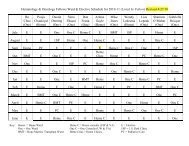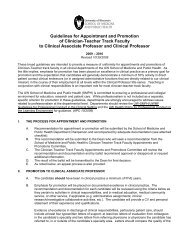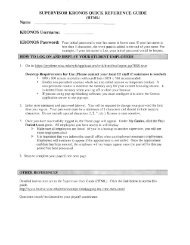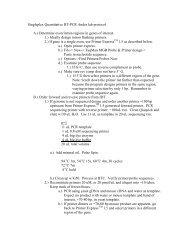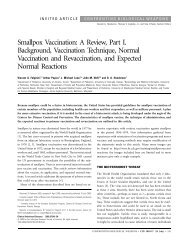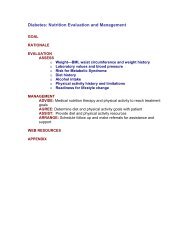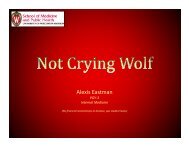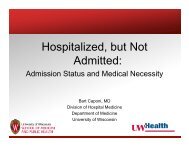Original article Association between CD4 CD25 T cells and atopy in ...
Original article Association between CD4 CD25 T cells and atopy in ...
Original article Association between CD4 CD25 T cells and atopy in ...
You also want an ePaper? Increase the reach of your titles
YUMPU automatically turns print PDFs into web optimized ePapers that Google loves.
ARTICLE IN PRESS<strong>Orig<strong>in</strong>al</strong> <strong>article</strong><strong>Association</strong> <strong>between</strong> <strong>CD4</strong> 1 <strong>CD25</strong> high T <strong>cells</strong><strong>and</strong> <strong>atopy</strong> <strong>in</strong> childrenTuomas Jartti, MD, a Kristjan A. Burmeister, BS, a Christ<strong>in</strong>e M. Seroogy, MD, a Martha L.Jennens-Clough, BA, a Christopher J. Tisler, MT, a Lisa P. Salazar, BA, a Douglas F.DaSilva, BS, a Michael D. Evans, MS, b Rose F. Vrtis, BS, a Paul K. Wallace, PhD, cBegona Ruiz-Perez, PhD, d Ronald E. Gangnon, PhD, b Robert F. Lemanske, Jr, MD, a,e<strong>and</strong> James E. Gern, MD a Madison, Wis, Buffalo, NY, <strong>and</strong> Boston, MassBackground: There is evidence that <strong>CD4</strong> 1 <strong>CD25</strong> highT-regulatory <strong>cells</strong> are important for establish<strong>in</strong>g toleranceto allergens, but <strong>in</strong>formation <strong>in</strong> children is limited.Objective: To test the hypothesis that greater numbers <strong>and</strong>function of <strong>CD4</strong> 1 <strong>CD25</strong> high T <strong>cells</strong> are associated with a reducedrisk of childhood allergies <strong>and</strong> wheez<strong>in</strong>g.Methods: A cohort of 151 six-year-old children from atopicfamilies was analyzed for peripheral blood <strong>CD4</strong> 1 <strong>CD25</strong> high <strong>and</strong><strong>CD4</strong> 1 <strong>CD25</strong> <strong>in</strong>t T <strong>cells</strong> by flow cytometry <strong>and</strong> for cl<strong>in</strong>ical <strong>and</strong>immunologic correlates of <strong>atopy</strong>. The associations <strong>between</strong>these variables were assessed by regression analysis.Results: Factors positively associated with % <strong>CD4</strong> 1 <strong>CD25</strong> high /<strong>CD4</strong> T <strong>cells</strong> were male sex, number of positive allergen-specificIgE tests, total IgE, season, <strong>and</strong> 1-month average total pollencount preced<strong>in</strong>g blood draw. The percentage of <strong>CD4</strong> 1 <strong>CD25</strong> high /total <strong>CD4</strong> T <strong>cells</strong> did not correlate with <strong>in</strong>duced cytok<strong>in</strong>eproduction, <strong>and</strong> correlated negatively with suppressivecapacity of <strong>CD4</strong> 1 <strong>CD25</strong> 1 T <strong>cells</strong> (r 5 –0.45; P 5 .034). Thepercentage of <strong>CD4</strong> 1 <strong>CD25</strong> <strong>in</strong>t /<strong>CD4</strong> T <strong>cells</strong> was 54% higher <strong>in</strong>pollen-sensitized children compared with nonsensitizedchildren <strong>in</strong> spr<strong>in</strong>g (P 5 .023 for <strong>in</strong>teraction), <strong>and</strong> correlatedpositively with IL-5, IL-10, <strong>and</strong> IL-13 (P # .001 for all).Conclusion: Our f<strong>in</strong>d<strong>in</strong>gs suggest that blood <strong>CD4</strong> 1 <strong>CD25</strong> high<strong>cells</strong> are a mixture of activated <strong>and</strong> regulatory T <strong>cells</strong>, <strong>and</strong> thatthese <strong>cells</strong> could be seasonally regulated by environmentalfactors such as pollen exposure.From the Departments of a Pediatrics, b Biostatistics <strong>and</strong> Medical Informatics,<strong>and</strong> e Medic<strong>in</strong>e, University of Wiscons<strong>in</strong>;c the Department of FlowCytometry, Roswell Park Cancer Institute, Buffalo; <strong>and</strong> d the Chann<strong>in</strong>gLaboratory, Harvard Medical School, Brigham <strong>and</strong> Women’s Hospital,Boston.Supported by National Institutes of Health grants P01 HL70831, R01HL080072, <strong>and</strong> M01 RR03186 from the General Cl<strong>in</strong>ical ResearchCenters Program of the National Center for Research Resources, theAcademy of F<strong>in</strong>l<strong>and</strong>, the F<strong>in</strong>nish Cultural Foundation, the PauloFoundation, <strong>and</strong> the Turku University Foundation.Disclosure of potential conflict of <strong>in</strong>terest: R. F. Lemanske has consult<strong>in</strong>garrangements with Merck, GlaxoSmithKl<strong>in</strong>e, AstraZeneca, <strong>and</strong> Novartis;has received grant support from the National Heart, Lung, <strong>and</strong> BloodInstitute <strong>and</strong> the National Institute of Allergy <strong>and</strong> Infectious Diseases; <strong>and</strong>is on the speakers’ bureau for Merck <strong>and</strong> GlaxoSmithKl<strong>in</strong>e. The rest ofthe authors have declared that they have no conflict of <strong>in</strong>terest.Received for publication November 16, 2006; revised March 6, 2007; acceptedfor publication March 8, 2007.Repr<strong>in</strong>t requests: James E. Gern MD, K4/918 CSC, 600 Highl<strong>and</strong> Avenue,Madison, WI 53792-4108. E-mail: Gern@medic<strong>in</strong>e.wisc.edu.0091-6749/$32.00Ó 2007 American Academy of Allergy, Asthma & Immunologydoi:10.1016/j.jaci.2007.03.008Cl<strong>in</strong>ical implications: Seasonal <strong>in</strong>creases <strong>in</strong> <strong>CD4</strong><strong>CD25</strong> highexpression <strong>in</strong> children with allergy may represent systemicimmune activation caused by pollen exposures. (J Allergy Cl<strong>in</strong>Immunol nnnn;nnn:nnn-nnn.)Key words: Regulatory <strong>CD4</strong> 1 <strong>CD25</strong> 1 T cell, activated T cell,seasonality, <strong>atopy</strong>, pollen sensitization, cytok<strong>in</strong>e, wheez<strong>in</strong>g, atopicdermatitis, sex, childThe activation of T H 2 <strong>cells</strong> is considered to be crucial <strong>in</strong>allergic sensitization. 1 T H 2 <strong>cells</strong> produce cytok<strong>in</strong>es, suchas IL-4, IL-5, <strong>and</strong> IL-13, that mediate IgE synthesis <strong>and</strong>eos<strong>in</strong>ophilic <strong>in</strong>flammation <strong>and</strong> altogether contribute toairway hyperresponsiveness. Why atopic <strong>in</strong>dividuals developT H 2 responses to allergens whereas nonatopic subjectsdo not is <strong>in</strong>completely understood. One possibleexplanation may be the <strong>in</strong>fluence of T-regulatory (T reg )<strong>cells</strong> that serve to promote tolerance to allergic <strong>and</strong> other<strong>in</strong>flammatory stimuli. <strong>CD4</strong> 1 <strong>CD25</strong> 1 T reg <strong>cells</strong> are generated<strong>in</strong> the thymus <strong>and</strong> reside <strong>in</strong> the blood <strong>and</strong> otherperipheral lymphoid tissues at a frequency of 5% to 10%of total <strong>CD4</strong> 1 <strong>cells</strong>. 2 It has been suggested that pollenexposure <strong>in</strong>creases the number of <strong>CD4</strong> 1 <strong>CD25</strong> 1 T <strong>cells</strong> <strong>in</strong>subjects with pollen allergy, <strong>and</strong> that allergy may be associatedwith defective function of regulatory <strong>CD4</strong> 1 <strong>CD25</strong> 1T <strong>cells</strong>, which are unable to suppress pollen-<strong>in</strong>duced activationof <strong>CD4</strong> 1 <strong>CD25</strong> – T <strong>cells</strong> dur<strong>in</strong>g pollen seasons. 3-5One limitation of these studies is that activated <strong>and</strong>regulatory <strong>CD4</strong> 1 T <strong>cells</strong> have overlapp<strong>in</strong>g expression of<strong>CD25</strong>, despite quite different functional capabilities. The2 basic features of <strong>CD4</strong> 1 <strong>CD25</strong> 1 T reg <strong>cells</strong> are an anergicresponse to antigen stimulation <strong>and</strong> the ability to suppressproliferation of <strong>CD4</strong> 1 <strong>CD25</strong> – T <strong>cells</strong> <strong>in</strong> a contact-dependentfashion. 5-10 Selection of the <strong>CD4</strong> 1 <strong>CD25</strong> high subsetof <strong>CD4</strong> 1 <strong>CD25</strong> 1 T <strong>cells</strong> has been suggested to m<strong>in</strong>imizethe coisolation of contam<strong>in</strong>at<strong>in</strong>g activated <strong>CD4</strong> 1 T <strong>cells</strong>.Furthermore, forkhead/w<strong>in</strong>ged helix transcription factortranscription factor (FOXP3), which is predom<strong>in</strong>antlyexpressed by <strong>CD4</strong> 1 <strong>CD25</strong> 1 T <strong>cells</strong>, appears to be a morespecific marker for <strong>CD4</strong> 1 <strong>CD25</strong> 1 T reg <strong>cells</strong>. 11,12In general, the knowledge on the role <strong>and</strong> suppressiveeffect of <strong>CD4</strong> 1 <strong>CD25</strong> 1 T reg <strong>cells</strong> <strong>in</strong> atopic subjects isstill limited, especially <strong>in</strong> children, <strong>and</strong> somewhat1
2 Jartti et alARTICLE IN PRESSJ ALLERGY CLIN IMMUNOLnnn 2007Abbreviations usedCOAST: Childhood Orig<strong>in</strong>s of ASThmaFOXP3: Forkhead/w<strong>in</strong>ged helix transcriptionfactor transcription factorSPT: Sk<strong>in</strong> prick testT reg : T-regulatorycontradictory. 10 To test the hypothesis that T reg <strong>cells</strong>reduce the risk of develop<strong>in</strong>g allergy <strong>and</strong> wheez<strong>in</strong>g <strong>in</strong>childhood, we compared the number <strong>and</strong> function of<strong>CD4</strong> 1 <strong>CD25</strong> high T <strong>cells</strong> to several cl<strong>in</strong>ical <strong>and</strong> immunologicfactors <strong>in</strong> a well characterized group of childrenborn to atopic families.METHODSStudy subjects <strong>and</strong> study design<strong>Orig<strong>in</strong>al</strong>ly, 289 subjects were enrolled <strong>in</strong> the Childhood Orig<strong>in</strong>s ofASThma (COAST) study at birth, <strong>and</strong> 257 were followed prospectivelyfor at least 6 years. Of these 257 children, flow-cytometricanalysis of PBMCs was performed for 151 children at the scheduled6-year visit <strong>between</strong> February 2005 <strong>and</strong> March 2006. With<strong>in</strong> this timeframe, all COAST participants with enough PBMCs (2-4 3 10 6 <strong>cells</strong>after COAST cytok<strong>in</strong>e secretion assays were completed) for the flowcytometricanalysis at the 6-year visit (close to the birthday) were <strong>in</strong>cluded<strong>in</strong> this study. Flow-cytometric data were correlated with othercl<strong>in</strong>ical <strong>and</strong> laboratory data obta<strong>in</strong>ed at age 5 to 6 years.To be eligible, each of the COAST children was required to have1 or both parents with allergic sensitization (1 or more positiveaeroallergen sk<strong>in</strong> tests) <strong>and</strong>/or asthma (by history), 37 weeks ofgestation, <strong>and</strong> be otherwise healthy. Details of study population <strong>and</strong>design have been described previously. 13 This study was approvedby University of Wiscons<strong>in</strong> Human Subjects Committee <strong>and</strong> commencedonly after obta<strong>in</strong><strong>in</strong>g <strong>in</strong>formed consent.Flow cytometryWith<strong>in</strong> 24 hours of blood draw, PBMCs were isolated <strong>and</strong> werethen sta<strong>in</strong>ed with antibody/conjugate: CD3/perid<strong>in</strong><strong>in</strong> chlorophyllprote<strong>in</strong>, <strong>CD4</strong>/allophycocyan<strong>in</strong>-7, <strong>CD25</strong>/allophycocyan<strong>in</strong>, CD62L/phycoerythr<strong>in</strong>-cyan<strong>in</strong>e 5, <strong>CD4</strong>5RA/fluoresce<strong>in</strong> isothiocyanate, <strong>and</strong>glucocorticoid-<strong>in</strong>duced TNF receptor–related gene/phycoerythr<strong>in</strong>(BD Biosciences, San Jose, Calif; see this <strong>article</strong>’s Methods <strong>in</strong> theOnl<strong>in</strong>e Repository at www.jacionl<strong>in</strong>e.org). Cells were analyzed on aLSR II (3-laser, 11-color benchtop flow cytometer; BD Biosciences)with<strong>in</strong> 48 hours of blood draw. CD3 1 <strong>CD4</strong> 1 <strong>CD25</strong> – <strong>cells</strong> were determ<strong>in</strong>edby comparison with <strong>cells</strong> sta<strong>in</strong>ed with an isotype control.Beg<strong>in</strong>n<strong>in</strong>g <strong>in</strong> March 2006, PBMC samples (n 5 32; age 6-7 years)were analyzed for <strong>in</strong>tracellular FOXP3 expression after the surfacesta<strong>in</strong><strong>in</strong>g described. After <strong>cells</strong> were fixed <strong>and</strong> permeabilized(BioLegend, San Diego, Calif), they were <strong>in</strong>cubated with AlexaFluor 488 conjugated antihuman FOXP3 accord<strong>in</strong>g to the manufacturer’s<strong>in</strong>structions (BioLegend) <strong>and</strong> analyzed on a LSR II immediatelyafter the sta<strong>in</strong><strong>in</strong>g procedure. <strong>CD4</strong> 1 <strong>CD25</strong> 1 FOXP3 1 <strong>cells</strong> weredeterm<strong>in</strong>ed by comparison with <strong>cells</strong> sta<strong>in</strong>ed with an isotype control.Depletion of <strong>CD4</strong> 1 <strong>CD25</strong> 1 T <strong>cells</strong>An antibody-coated microbead isolation procedure was used forthe depletion of <strong>CD4</strong> 1 <strong>CD25</strong> 1 T <strong>cells</strong> (Miltenyi Biotec Inc, Auburn,Calif; see this <strong>article</strong>’s Methods <strong>in</strong> the Onl<strong>in</strong>e Repository atwww.jacionl<strong>in</strong>e.org). This depletion protocol decreased mean<strong>CD4</strong> 1 <strong>CD25</strong> high T-cell count by 62% (undepleted vs <strong>CD4</strong> 1 <strong>CD25</strong> 1depleted PBMCs, 8.7% vs 3.4%; n 5 7; Fig 1, A) <strong>and</strong> <strong>in</strong>creasedmean anti-CD3/anti-CD28–<strong>in</strong>duced proliferation by 17%.Proliferation assayTo obta<strong>in</strong> a functional measure of T reg activity, we used the proliferationsuppression assay as described by Taams et al, 14 with modifications(see this <strong>article</strong>’s Methods <strong>in</strong> the Onl<strong>in</strong>e Repository atwww.jacionl<strong>in</strong>e.org). Suppressive activity of <strong>CD4</strong> 1 <strong>CD25</strong> 1 <strong>cells</strong>was estimated by divid<strong>in</strong>g proliferative responses of <strong>CD4</strong><strong>CD25</strong>-depleted PBMCs to responses by the same <strong>cells</strong> that had been repletedby add<strong>in</strong>g back <strong>CD4</strong> 1 <strong>CD25</strong> 1 <strong>cells</strong> <strong>in</strong> a 1:4 ratio. Larger <strong>in</strong>dicesrepresent more <strong>CD4</strong> 1 <strong>CD25</strong> 1 suppressive capacity.Total IgE <strong>and</strong> allergy testsTotal <strong>and</strong> allergen-specific IgE for birch, grass mix, ragweed,Dermatophagoides pteronyss<strong>in</strong>us, Dermatophagoides far<strong>in</strong>ae,Alternaria alternata, cat, dog, cockroach, egg, <strong>and</strong> peanut were analyzed<strong>in</strong> 146 subjects by UniCAP 100 E as described previously. 15 Thesensitivity for detection of total IgE was 2 kU/L. Allergen-specificIgE values of 0.35 kU/L were considered positive.Sk<strong>in</strong> prick test<strong>in</strong>g (Multi-Test II; L<strong>in</strong>coln Diagnostics, Decatur,Ill) was performed <strong>in</strong> 143 subjects for eastern tree mix, grass mix,weed mix, ragweed, Alternaria alternata, Cladosporium herbarum,Aspergillus fumigatus, Dermatophagoides pteronyss<strong>in</strong>us, Dermatophagoidesfar<strong>in</strong>ae, dog epithelium, cat hair, <strong>and</strong> American/Germancockroach (reagents <strong>and</strong> controls obta<strong>in</strong>ed from Greer Laboratories,Lenoir, NC). Tests were regarded as positive when the mean diameterof the wheal (half the sum of the largest diameter <strong>and</strong> its perpendicularmeasurement) was 3 mm or greater.Immunologic studiesSpecimens of peripheral blood at age 6 years <strong>and</strong> cytok<strong>in</strong>eresponses were performed as previously described. 15,16 PBMCswere <strong>in</strong>cubated with phytohemagglut<strong>in</strong><strong>in</strong> (5 mg/mL) or mediumalone, <strong>and</strong> supernatant fluids collected 2 days later were analyzedfor IFN-g, IL-5, IL-10, <strong>and</strong> IL-13 by ELISA (Pharm<strong>in</strong>gen, SanDiego, Calif). The sensitivities of the ELISA were as follows:IFN-g, 3.1 pg/mL; IL-5, 1.9 pg/mL; IL-10, 7.8 pg/mL; <strong>and</strong> IL-13,3.1 pg/mL.Pollen measurementsPollen sampl<strong>in</strong>g was conducted at the University of Wiscons<strong>in</strong>School of Medic<strong>in</strong>e <strong>and</strong> Public Health us<strong>in</strong>g Rotorod Samplers(Sampl<strong>in</strong>g Technologies, M<strong>in</strong>netonka, M<strong>in</strong>n) <strong>in</strong> accordance withst<strong>and</strong>ards outl<strong>in</strong>ed by the Aeroallergen Monitor<strong>in</strong>g Network ofthe American Academy of Allergy, Asthma, <strong>and</strong> Immunology(Milwaukee, Wis). 17Cl<strong>in</strong>ical def<strong>in</strong>itionsSensitization was def<strong>in</strong>ed either by a positive allergen-specific IgEtest result at age 6 years or by a positive allergen-specific sk<strong>in</strong> pricktest (SPT) result at age 5 years or later. Pollen sensitization wasdef<strong>in</strong>ed as a positive IgE or SPT result for birch, eastern tree mix,grass mix, weed mix, or ragweed. Atopic dermatitis at age 6 years wasdef<strong>in</strong>ed by a parental report of physician-diagnosed atopic dermatitis.Wheez<strong>in</strong>g history <strong>in</strong> the 6th year of life was documented byquestionnaires at the 6th year protocol-scheduled visit that askedthe parent whether the child had ever wheezed dur<strong>in</strong>g the past year.StatisticsL<strong>in</strong>ear regression models were used to assess the relationshipof cl<strong>in</strong>ical <strong>and</strong> seasonal factors with log-transformed proportions of
J ALLERGY CLIN IMMUNOLVOLUME nnn, NUMBER nnARTICLE IN PRESSJartti et al 3FIG 1. A, The magnetic depletion of <strong>CD4</strong> 1 <strong>CD25</strong> 1 T <strong>cells</strong> decreased mean <strong>CD4</strong> 1 <strong>CD25</strong> high T-cell count of <strong>CD4</strong> 1T <strong>cells</strong> by 62%: undepleted (white) vs <strong>CD4</strong> 1 <strong>CD25</strong> 1 depleted PBMCs (gray), 8.7% vs 3.4%; n 5 7. B, <strong>CD4</strong> 1 <strong>CD25</strong> –T <strong>cells</strong> were determ<strong>in</strong>ed by comparison with <strong>cells</strong> sta<strong>in</strong>ed with an isotype control, <strong>and</strong> <strong>CD4</strong> 1 <strong>CD25</strong> high T <strong>cells</strong>were identified visually as a dist<strong>in</strong>ct population with slightly lower <strong>CD4</strong> expression compared with the<strong>CD4</strong> 1 <strong>CD25</strong> <strong>in</strong>t <strong>and</strong> <strong>CD4</strong> 1 <strong>CD25</strong> – fractions.T-cell subsets, <strong>in</strong> both univariate <strong>and</strong> multivariate models. Cl<strong>in</strong>ical<strong>and</strong> seasonal factors <strong>in</strong>cluded sex; sensitization status grouped aspollen, other, or no sensitization; number of positive test results ofspecific IgE <strong>and</strong> SPTs; total IgE; active atopic dermatitis; activewheez<strong>in</strong>g illness; season grouped as quarters of year; any controllermedication (any on-dem<strong>and</strong> or cont<strong>in</strong>uous medication for allergy orwheez<strong>in</strong>g exclud<strong>in</strong>g creams); <strong>and</strong> cont<strong>in</strong>uous <strong>in</strong>haled corticosteroidmedication. Regression coefficients are back-transformed to representpercent change <strong>in</strong> the mean proportion of T-cell subsets. <strong>Association</strong>s<strong>between</strong> immunologic factors <strong>and</strong> T-cell subsets were assessed us<strong>in</strong>gPearson or Spearman rank correlation coefficients when appropriate.A nom<strong>in</strong>al P value of .05 was regarded as statistically significant.RESULTSThe study population was composed of 151 childrenwho had blood samples analyzed by flow cytometry at age6 years. There were slightly more boys (59%; 89/151) thangirls (see this <strong>article</strong>’s Table E1 <strong>in</strong> the Onl<strong>in</strong>e Repository atwww.jacionl<strong>in</strong>e.org). More than half of the children weresensitized def<strong>in</strong>ed as either a positive allergen-specific IgEtest result at age 6 years (any, 48%, 70/146; pollen, 20%,29/146) or a positive allergen-specific SPT result at age5 years or later (any, 47%, 67/143; pollen, 22%, 32/143).Overall, 30% (45/151) had pollen sensitization, <strong>and</strong> 27%(40/151) of children were sensitized to allergens otherthan pollen. Thirty-six percent (54/151) had active atopicdermatitis with<strong>in</strong> the past year, <strong>and</strong> 21% (32/149) wheezeddur<strong>in</strong>g the 6th year of life. Use of controller medication forallergic or wheez<strong>in</strong>g illnesses was low (11%; 14/133).<strong>Association</strong>s with <strong>CD4</strong><strong>CD25</strong> T-cell phenotypeThe def<strong>in</strong>ition of CD3 1 <strong>CD4</strong> 1 <strong>CD25</strong> high <strong>cells</strong> wasestablished a priori, <strong>and</strong> the cell populations were identifiedby a technician bl<strong>in</strong>d to protocol outcomes. Gateswere drawn to capture a dist<strong>in</strong>ct population with high<strong>CD25</strong> expression <strong>and</strong> slightly lower <strong>CD4</strong> expressioncompared with other <strong>cells</strong> (Fig 1, B). CD3 1 <strong>CD4</strong> 1 <strong>CD25</strong> <strong>in</strong>twas determ<strong>in</strong>ed as those <strong>cells</strong> express<strong>in</strong>g levels of <strong>CD25</strong><strong>between</strong> that of the CD3 1 <strong>CD4</strong> 1 <strong>CD25</strong> – <strong>and</strong>CD3 1 <strong>CD4</strong> 1 <strong>CD25</strong> high populations (Fig 1, B). By univariateanalysis (Table I), the percentage of <strong>CD4</strong> 1 <strong>CD25</strong> high /<strong>CD4</strong> T <strong>cells</strong> (median, 5.6%; <strong>in</strong>terquartile range, 4.8-6.8)was associated with male sex, number of positive specificIgE test results, total IgE, <strong>and</strong> season. In addition, therewas a trend toward a positive association <strong>between</strong> %<strong>CD4</strong> 1 <strong>CD25</strong> high /<strong>CD4</strong> T <strong>cells</strong> <strong>and</strong> the number of positiveSPT results. In contrast, the percentage of <strong>CD4</strong> 1<strong>CD25</strong> <strong>in</strong>t /<strong>CD4</strong> 1 T <strong>cells</strong> (median, 4.3%; <strong>in</strong>terquartile range,3.0-5.9) was not significantly associated with any of thesefactors, although there was a trend <strong>in</strong> univariate modelstoward a positive association with total IgE.In multivariate models (Table I), the associations withtotal IgE <strong>and</strong> season rema<strong>in</strong>ed significant. The percentagesof <strong>CD4</strong> 1 <strong>CD25</strong> high /<strong>CD4</strong> T <strong>cells</strong> <strong>and</strong> % <strong>CD4</strong> 1 <strong>CD25</strong> <strong>in</strong>t /<strong>CD4</strong> 1 T <strong>cells</strong> were loosely correlated (r 5 0.19; P 5 .020).F<strong>in</strong>ally, % <strong>CD4</strong> 1 <strong>CD25</strong> <strong>in</strong>t /<strong>CD4</strong> 1 T <strong>cells</strong> were weakly associatedwith total IgE <strong>and</strong> <strong>in</strong>versely correlated with thenumber of positive allergen-specific IgE test results(Table I).Relationship of <strong>CD25</strong> <strong>and</strong> FOXP3 expressionFlow-cytometric analysis of FOXP3 was performed ona subset of samples beg<strong>in</strong>n<strong>in</strong>g March 2006 (Fig 2). Onaverage, 2.9% of <strong>CD4</strong> <strong>cells</strong> expressed FOXP3 (n 5 32).The percentage of FOXP3-express<strong>in</strong>g <strong>cells</strong> <strong>in</strong>creasedwith expression of <strong>CD25</strong> (P
4 Jartti et alARTICLE IN PRESSJ ALLERGY CLIN IMMUNOLnnn 2007TABLE I. Cl<strong>in</strong>ical or seasonal factors associat<strong>in</strong>g with <strong>CD4</strong> 1 <strong>CD25</strong> high <strong>and</strong> <strong>CD4</strong> 1 <strong>CD25</strong> <strong>in</strong>t T-cell counts*FactornPercenteffectyPercent <strong>CD4</strong> 1 <strong>CD25</strong> high /<strong>CD4</strong> T <strong>cells</strong>Percent <strong>CD4</strong> 1 <strong>CD25</strong> <strong>in</strong>t /<strong>CD4</strong> T <strong>cells</strong>Univariate Multivariate n 5 120 Univariate Multivariate n 5 12095%CIPvaluePercenteffect95%CIPvaluePercenteffect95%CIPvaluePercenteffectMale sex 151 11 1.0-21 .029 7.6 22.3-18 .14 12 24.4-31 .16 4.0 215-25 .67Any sensitization 151 6.8 22.4-17 .15 7.5 28.1-26 .36Sensitization groupà 151 .11 1.00 .61 .54Pollen vs no11 0.4-24 2.1 211-13 9.6 28.9-32 8.1 214-36sensitizationOther vs no1.7 28.9-14 0.4 215-18 5.3 213-27 19 212-61sensitizationNo. of positivetest resultsSpecific IgE 146 2.0 0.0-4.0 .048 22.1 25.5-1.2 .21 0.6 22.8-4.1 .74 –7.9 –14-1.6 .013SPT 143 1.8 20.0-3.8 .056 0.7 22.2-3.7 .63 0.1 23.0-3.4 .94 2.8 22.8-8.6 .33Log 10 total IgE 146 3.6 1.5-5.8 .0007 5.6 2.3-9.0 .0007 3.1 20.5-7.0 .093 6.5 0.3-13 .038(per doubl<strong>in</strong>g)Atopic dermatitis 151 3.2 26.1-13 .51 1.3 27.7-11.3 .78 4.1 212-23 .62 3.2 213-23 .73Wheez<strong>in</strong>g 151 26.5 216-4.1 .22 23.8 219-14 .65 28.6 225-11 .35 211 236-24 .49Season§ 151
J ALLERGY CLIN IMMUNOLVOLUME nnn, NUMBER nnARTICLE IN PRESSJartti et al 5FIG 2. Intracellular FOXP3 expression on CD3 1 <strong>CD4</strong> 1 <strong>CD25</strong> 1 <strong>cells</strong>.PBMCs were sta<strong>in</strong>ed with CD3/Pacific Blue, <strong>CD4</strong>/allophycocyan<strong>in</strong>-7, <strong>CD25</strong>/phycoerythr<strong>in</strong>, <strong>and</strong> CD62L/phycoerythr<strong>in</strong>-cyan<strong>in</strong>e 5 <strong>and</strong>then <strong>in</strong>tracellular-sta<strong>in</strong>ed with an Alexa Fluor 488 isotype control(A) or Alexa Fluor 488 antihuman FOXP3 (B).FIG 4. Seasonal changes <strong>in</strong> <strong>CD4</strong> 1 <strong>CD25</strong> high <strong>and</strong> <strong>CD4</strong> 1 <strong>CD25</strong> <strong>in</strong>t T-cellcounts <strong>and</strong> total pollen counts. T-cell curves were fitted accord<strong>in</strong>gto each 50 values <strong>and</strong> pollen curves accord<strong>in</strong>g to each 10 values.One gra<strong>in</strong> <strong>in</strong>crease per m 3 of air <strong>in</strong> the 1-month average total pollencount preced<strong>in</strong>g blood draw was associated with 0.10% (95% CI,0.050, 0.15) <strong>in</strong>crease <strong>in</strong> % <strong>CD4</strong> 1 <strong>CD25</strong> high /<strong>CD4</strong> (P < .001).FIG 3. Seasonal changes <strong>in</strong> % <strong>CD4</strong> 1 <strong>CD25</strong> high /<strong>CD4</strong> T <strong>cells</strong> (A) <strong>and</strong> %<strong>CD4</strong> 1 <strong>CD25</strong> <strong>in</strong>t /<strong>CD4</strong> T <strong>cells</strong> (B) grouped accord<strong>in</strong>g to sensitization status(none, white; other than pollen, light gray; pollen, dark gray). Inspr<strong>in</strong>g, pollen-sensitized children had a 54% higher <strong>CD4</strong> 1 <strong>CD25</strong> <strong>in</strong>t /<strong>CD4</strong> T-cell count than nonsensitized children (95% CI, 7.3, 161) bymultivariate analysis (P 5 .023 for <strong>in</strong>teraction). Sample sizes forw<strong>in</strong>ter, spr<strong>in</strong>g, summer, <strong>and</strong> fall seasons, respectively, are 49, 34,40, <strong>and</strong> 28.FIG 5. Correlation <strong>between</strong> % <strong>CD4</strong> 1 <strong>CD25</strong> high /<strong>CD4</strong> T <strong>cells</strong> <strong>and</strong> suppressivecapacity of <strong>CD4</strong> 1 <strong>CD25</strong> 1 T <strong>cells</strong>. Suppressive ratio was def<strong>in</strong>edas <strong>CD4</strong> 1 <strong>CD25</strong> 1 depleted/1:4 <strong>CD4</strong> 1 <strong>CD25</strong> 1 enriched PBMCs;larger <strong>in</strong>dices represent greater <strong>CD4</strong> 1 <strong>CD25</strong> 1 suppressive capacity.other (P 5 .56), active atopic dermatitis (P 5 .85), or activewheez<strong>in</strong>g (P 5 .88) <strong>in</strong> univariate analyses (data notshown).F<strong>in</strong>ally, we compared <strong>CD4</strong><strong>CD25</strong> T-cell phenotype withthe capacity of PBMCs to secrete selected cytok<strong>in</strong>es <strong>in</strong>response to phytohemagglut<strong>in</strong><strong>in</strong> stimulation. The proportionof <strong>CD4</strong> 1 T <strong>cells</strong> express<strong>in</strong>g <strong>in</strong>termediate amounts of<strong>CD25</strong> correlated positively with IL-5 (r 5 0.35; P 5.0010), IL-10 (r 5 0.29; P 5 .0071), <strong>and</strong> IL-13 (r 50.42; P
6 Jartti et alARTICLE IN PRESSJ ALLERGY CLIN IMMUNOLnnn 2007FIG 6. Correlations <strong>between</strong> % <strong>CD4</strong> 1 <strong>CD25</strong> <strong>in</strong>t /<strong>CD4</strong> T <strong>cells</strong> <strong>and</strong> IL-5 (A), IL-10 (B), <strong>and</strong> IL-13 (C) production byphytohemagglut<strong>in</strong><strong>in</strong>-stimulated PBMCs.<strong>CD4</strong> 1 <strong>CD25</strong> 1 T <strong>cells</strong> from atopic <strong>in</strong>dividuals could befunctionally impaired. Alternatively, <strong>CD4</strong> 1 <strong>CD25</strong> high <strong>cells</strong>from such <strong>in</strong>dividuals could represent a mixture of regulatory<strong>and</strong> activated T <strong>cells</strong>: proliferative responses of thelatter population could thereby mask the effect of regulatoryT <strong>cells</strong>.In agreement with others, 18 we showed that there isoverlap <strong>in</strong> the <strong>CD25</strong> expression of activated versus regulatoryT <strong>cells</strong>, thereby limit<strong>in</strong>g the utility of this markerto dist<strong>in</strong>guish specific T-cell functional subsets. The transcriptionfactor FOXP3 has been shown to be a key regulatorygene for the development <strong>and</strong> function of regulatory<strong>CD4</strong> 1 <strong>CD25</strong> 1 T <strong>cells</strong> <strong>and</strong> is selectively expressed by these<strong>cells</strong>. 11,12,19 Notably, although FOXP3 expression <strong>in</strong>creasedwith the level of <strong>CD25</strong>, even the brightest<strong>CD4</strong> 1 <strong>CD25</strong> 1 <strong>cells</strong> conta<strong>in</strong>ed some FOXP3 – <strong>cells</strong>.The seasonal variation <strong>in</strong> our cl<strong>in</strong>ical specimens suggeststhat natural exposures, perhaps related to pollen,<strong>in</strong>duce <strong>CD4</strong> 1 <strong>CD25</strong> high <strong>cells</strong> <strong>in</strong> vivo, <strong>and</strong> these <strong>CD25</strong> high<strong>cells</strong> appear to be a mixture of activated <strong>and</strong> regulatory<strong>cells</strong>. For example, <strong>CD4</strong> 1 <strong>CD25</strong> high <strong>cells</strong> correlated positivelywith total IgE, <strong>and</strong> <strong>in</strong>versely with <strong>CD4</strong> 1 <strong>CD25</strong> 1suppressive capacity, suggest<strong>in</strong>g the presence of activated<strong>cells</strong>. On the other h<strong>and</strong>, there was a negative correlation<strong>between</strong> % FOXP3/<strong>CD4</strong> 1 25 brightest <strong>cells</strong> <strong>and</strong> total IgE,suggest<strong>in</strong>g a regulatory function for this cell subset.Interest<strong>in</strong>gly, activation of <strong>CD4</strong> 1 <strong>CD25</strong> – <strong>cells</strong> can <strong>in</strong>duce<strong>CD25</strong> expression <strong>in</strong> vitro, <strong>and</strong> a subset of these activated<strong>cells</strong> synthesizes FOXP3 19,20 <strong>and</strong> has suppressive capacity.19,21 Consider<strong>in</strong>g these f<strong>in</strong>d<strong>in</strong>gs, we speculate that thenumber of T reg <strong>cells</strong> may <strong>in</strong>crease as a consequence ofallergen exposure <strong>and</strong> subsequent T-cell activation.Furthermore, the association <strong>between</strong> pollen counts <strong>and</strong>% <strong>CD4</strong> 1 <strong>CD25</strong> high <strong>cells</strong> was stronger <strong>in</strong> children withallergen-specific IgE, although this was not specific forpollen. It is conceivable that variations <strong>in</strong> T reg cell numberscould also be related to seasonal alterations <strong>in</strong> otherallergens. For example, house dust mite levels vary seasonally<strong>in</strong> the midwestern United States <strong>and</strong> generallypeak <strong>in</strong> the summer. 22 In addition, there may be other immunologicallyimportant seasonal allergens that were not<strong>in</strong> our test<strong>in</strong>g panel. F<strong>in</strong>ally, the seasonal variation <strong>in</strong> T reg<strong>cells</strong> may have also been driven by nonallergenic factors,such as exposure to seasonal <strong>in</strong>fectious diseases.Additional studies are needed to confirm whether thepattern of response is truly unique <strong>in</strong> allergic versus nonallergic<strong>in</strong>dividuals.The <strong>CD4</strong> 1 <strong>CD25</strong> <strong>in</strong>t T <strong>cells</strong> <strong>in</strong> our study probably representma<strong>in</strong>ly activated T <strong>cells</strong>, because the percentage ofthese <strong>cells</strong>, but not <strong>CD4</strong> 1 <strong>CD25</strong> high T <strong>cells</strong>, was associatedwith pollen sensitization <strong>in</strong> spr<strong>in</strong>g <strong>and</strong> strongly with T H 2cytok<strong>in</strong>e (IL-5 <strong>and</strong> IL-13), but not IFN-g, responses.Previous studies to relate the number or function ofperipheral blood <strong>CD4</strong> 1 <strong>CD25</strong> 1 T <strong>cells</strong> to other atopicphenotypes such as wheez<strong>in</strong>g <strong>and</strong> atopic dermatitis haveshown partly conflict<strong>in</strong>g results. In subjects with atopicdermatitis, a normal or <strong>in</strong>creased number of <strong>CD4</strong> 1 <strong>CD25</strong> 1T <strong>cells</strong> with normal immunosuppressive activity hasbeen reported. 23,24 In patients with asthma, <strong>in</strong>creased<strong>CD4</strong> 1 <strong>CD25</strong> 1 T <strong>cells</strong> have been reported dur<strong>in</strong>g acute exacerbation.25,26 We found no differences <strong>in</strong> T reg functionrelated to <strong>atopy</strong>, active atopic dermatitis, or a history ofwheez<strong>in</strong>g illnesses, although the number of observationswas small (n 5 22). Neither were there differences <strong>in</strong>the percentages of <strong>CD4</strong> 1 <strong>CD25</strong> 1 subsets (n 5 151).However, boys had higher <strong>CD4</strong> 1 <strong>CD25</strong> high T-cell countsthan girls by univariate analysis, <strong>and</strong> this suggests thatthere may be sex differences <strong>in</strong> development of T reg <strong>cells</strong>to correspond with sex-related differences <strong>in</strong> immunologicresponses <strong>and</strong> the prevalence of atopic diseases. 27Our study has some limitations. The available bloodsample volume for the functional assay was rather small <strong>in</strong>this study <strong>in</strong>volv<strong>in</strong>g young children, which limited thetypes of functional assays that were feasible. Depletion of<strong>CD4</strong> 1 <strong>CD25</strong> 1 T <strong>cells</strong> may not be an optimal method toassess suppressive function, although many studies havedone so. 3,7,10 Although the sample size of our seasonaldata is larger than previous studies assess<strong>in</strong>g seasonaleffects, additional power is desirable for <strong>in</strong>teraction analysisrelated to season, pollen sensitivity, <strong>and</strong> blood cellphenotype. F<strong>in</strong>ally, all the study participants were fromallergic families, <strong>and</strong> additional studies are needed toevaluate these relationships <strong>in</strong> unselected populations.Although all of the children <strong>in</strong> the COAST study haveatopic family histories, there are many healthy children<strong>in</strong> the study with no cl<strong>in</strong>ical or biological evidence of
J ALLERGY CLIN IMMUNOLVOLUME nnn, NUMBER nnARTICLE IN PRESSJartti et al 7allergic diseases, <strong>and</strong> these serve as our ma<strong>in</strong> controlgroup. We believe that the significant differences <strong>between</strong>atopic <strong>and</strong> nonatopic children <strong>in</strong> COAST are noteworthy<strong>and</strong> significant <strong>in</strong> underst<strong>and</strong><strong>in</strong>g l<strong>in</strong>ks <strong>between</strong> familialpredisposition <strong>and</strong> the development of atopic diseases.Additional studies are be<strong>in</strong>g designed to evaluate theserelationships <strong>in</strong> unselected populations, as well as <strong>in</strong> childrenliv<strong>in</strong>g <strong>in</strong> urban rather than suburban locations.In conclusion, despite previously published suggestionsthat <strong>CD4</strong> 1 <strong>CD25</strong> high T <strong>cells</strong> have high regulatoryactivity, our f<strong>in</strong>d<strong>in</strong>gs <strong>in</strong> children do not support a straightforwardrelationship <strong>between</strong> <strong>CD25</strong> phenotype <strong>and</strong> function.In fact, our f<strong>in</strong>d<strong>in</strong>gs suggest that <strong>CD4</strong> 1 <strong>CD25</strong> highT <strong>cells</strong> are seasonally regulated by environmental factors,<strong>and</strong> are likely to represent a mixture of activated <strong>and</strong> regulatoryT <strong>cells</strong>, especially <strong>in</strong> atopic children.REFERENCES1. Heaton T, Rowe J, Turner S, Aalberse RC, de Klerk N, SuriyaarachchiD, et al. An immunoepidemiological approach to asthma: identificationof <strong>in</strong>-vitro T-cell response patterns associated with different wheez<strong>in</strong>gphenotypes <strong>in</strong> children. Lancet 2005;365:142-9.2. Van Oosterhout AJ, Bloksma N. Regulatory T-lymphocytes <strong>in</strong> asthma.Eur Respir J 2005;26:918-32.3. L<strong>in</strong>g EM, Smith T, Nguyen XD, Pridgeon C, Dallman M, Arbery J, et al.Relation of <strong>CD4</strong>1<strong>CD25</strong>1 regulatory T-cell suppression of allergendrivenT-cell activation to atopic status <strong>and</strong> expression of allergic disease.Lancet 2004;363:608-15.4. Francis JN, Till SJ, Durham SR. Induction of IL-101<strong>CD4</strong>1<strong>CD25</strong>1T <strong>cells</strong> by grass pollen immunotherapy. J Allergy Cl<strong>in</strong> Immunol 2003;111:1255-61.5. Gr<strong>in</strong>debacke H, W<strong>in</strong>g K, Andersson AC, Suri-Payer E, Rak S, Rud<strong>in</strong> A.Defective suppression of Th2 cytok<strong>in</strong>es by <strong>CD4</strong><strong>CD25</strong> regulatory T <strong>cells</strong><strong>in</strong> birch allergics dur<strong>in</strong>g birch pollen season. Cl<strong>in</strong> Exp Allergy 2004;34:1364-72.6. Bell<strong>in</strong>ghausen I, Klostermann B, Knop J, Saloga J. Human<strong>CD4</strong>1<strong>CD25</strong>1 T <strong>cells</strong> derived from the majority of atopic donors areable to suppress TH1 <strong>and</strong> TH2 cytok<strong>in</strong>e production. J Allergy Cl<strong>in</strong>Immunol 2003;111:862-8.7. Jutel M, Akdis M, Budak F, Aebischer-Casaulta C, Wrzyszcz M, BlaserK, et al. IL-10 <strong>and</strong> TGF-beta cooperate <strong>in</strong> the regulatory T cell responseto mucosal allergens <strong>in</strong> normal immunity <strong>and</strong> specific immunotherapy.Eur J Immunol 2003;33:1205-14.8. Smith TR, Alex<strong>and</strong>er C, Kay AB, Larche M, Rob<strong>in</strong>son DS. Cat allergenpeptide immunotherapy reduces <strong>CD4</strong>(1) T cell responses to cat allergenbut does not alter suppression by <strong>CD4</strong>(1) <strong>CD25</strong>(1) T <strong>cells</strong>: a doublebl<strong>in</strong>dplacebo-controlled study. Allergy 2004;59:1097-101.9. Baecher-Allan C, Wolf E, Hafler DA. Functional analysis of highlydef<strong>in</strong>ed, FACS-isolated populations of human regulatory <strong>CD4</strong>1 <strong>CD25</strong>1T <strong>cells</strong>. Cl<strong>in</strong> Immunol 2005;115:10-8.10. Karlsson MR, Rugtveit J, Br<strong>and</strong>tzaeg P. Allergen-responsive<strong>CD4</strong>1<strong>CD25</strong>1 regulatory T <strong>cells</strong> <strong>in</strong> children who have outgrowncow’s milk allergy. J Exp Med 2004;199:1679-88.11. Fontenot JD, Gav<strong>in</strong> MA, Rudensky AY. Foxp3 programs the development<strong>and</strong> function of <strong>CD4</strong>1<strong>CD25</strong>1 regulatory T <strong>cells</strong>. Nat Immunol2003;4:330-6.12. Hori S, Nomura T, Sakaguchi S. Control of regulatory T cell developmentby the transcription factor Foxp3. Science 2003;299:1057-61.13. Lemanske RF Jr. The childhood orig<strong>in</strong>s of asthma (COAST) study.Pediatr Allergy Immunol 2002;13(suppl 15):38-43.14. Taams LS, Vukmanovic-Stejic M, Smith J, Dunne PJ, Fletcher JM,Plunkett FJ, et al. Antigen-specific T cell suppression by human<strong>CD4</strong>1<strong>CD25</strong>1 regulatory T <strong>cells</strong>. Eur J Immunol 2002;32:1621-30.15. Neaville WA, Tisler C, Anklam K, Gilbertson-White S, Hamilton R,Adler K, et al. Developmental cytok<strong>in</strong>e response profiles <strong>and</strong> the cl<strong>in</strong>ical<strong>and</strong> immunologic expression of <strong>atopy</strong> <strong>in</strong> <strong>in</strong>fancy. J Allergy Cl<strong>in</strong> Immunol2003;112:740-6.16. Copenhaver CC, Gern JE, Li Z, Shult PA, Rosenthal LA, Mikus LD, et al.Cytok<strong>in</strong>e response patterns, exposure to viruses, <strong>and</strong> respiratory <strong>in</strong>fections<strong>in</strong> the first year of life. Am J Respir Crit Care Med 2004;170:175-80.17. Smith EG. Sampl<strong>in</strong>g <strong>and</strong> identify<strong>in</strong>g allergenic pollens <strong>and</strong> molds: anillustrated manual for physicians <strong>and</strong> lab technicians. 1st ed. San Antonio(TX): Blewstone Press; 1984.18. Valencia X, Stephens G, Goldbach-Mansky R, Wilson M, Shevach EM,Lipsky PE. TNF downmodulates the function of human <strong>CD4</strong>1<strong>CD25</strong>hiT-regulatory <strong>cells</strong>. Blood 2006;108:253-61.19. Walker MR, Kasprowicz DJ, Gersuk VH, Benard A, Van L<strong>and</strong>eghen M,Buckner JH, et al. Induction of FoxP3 <strong>and</strong> acquisition of T regulatoryactivity by stimulated human <strong>CD4</strong>1. J Cl<strong>in</strong> Invest 2003;112:1437-43.20. Mantel PY, Ouaked N, Ruckert B, Karagiannidis C, Welz R, Blaser K,et al. Molecular mechanisms underly<strong>in</strong>g FOXP3 <strong>in</strong>duction <strong>in</strong> humanT <strong>cells</strong>. J Immunol 2006;176:3593-602.21. Lim HW, Hillsamer P, Banham AH, Kim CH. Cutt<strong>in</strong>g edge: directsuppression of B <strong>cells</strong> by <strong>CD4</strong>1 <strong>CD25</strong>1 regulatory T <strong>cells</strong>. J Immunol2005;175:4180-3.22. Arlian LG, Neal JS, Morgan MS, Vyszenski-Moher DL, Rapp CM,Alex<strong>and</strong>er AK. Reduc<strong>in</strong>g relative humidity is a practical way to controldust mites <strong>and</strong> their allergens <strong>in</strong> homes <strong>in</strong> temperate climates. J AllergyCl<strong>in</strong> Immunol 2001;107:99-104.23. Ou LS, Goleva E, Hall C, Leung DY. T regulatory <strong>cells</strong> <strong>in</strong> atopic dermatitis<strong>and</strong> subversion of their activity by superantigens. J Allergy Cl<strong>in</strong>Immunol 2004;113:756-63.24. Vukmanovic-Stejic M, McQuaid A, Birch KE, Reed JR, Macgregor C,Rust<strong>in</strong> MH, et al. Relative impact of <strong>CD4</strong>1<strong>CD25</strong>1 regulatory T <strong>cells</strong><strong>and</strong> tacrolimus on <strong>in</strong>hibition of T-cell proliferation <strong>in</strong> patients with atopicdermatitis. Br J Dermatol 2005;153:750-7.25. Gemou-Engesaeth V, Bush A, Kay AB, Hamid Q, Corrigan CJ. Inhaledglucocorticoid therapy of childhood asthma is associated with reducedperipheral blood T cell activation <strong>and</strong> ‘‘Th2-type’’ cytok<strong>in</strong>e mRNAexpression. Pediatr 1997;99:695-703.26. Shi HZ, Li S, Xie ZF, Q<strong>in</strong> XJ, Q<strong>in</strong> X, Zhong XN. Regulatory<strong>CD4</strong>1<strong>CD25</strong>1 T lymphocytes <strong>in</strong> peripheral blood from patients withatopic asthma. Cl<strong>in</strong> Immunol 2004;113:172-8.27. Uekert SJ, Akan G, Evans MD, Li Z, Roberg K, Tisler C, et al. Sexrelateddifferences <strong>in</strong> immune development <strong>and</strong> the expression of <strong>atopy</strong><strong>in</strong> early childhood. J Allergy Cl<strong>in</strong> Immunol 2006;118:1375-81.



